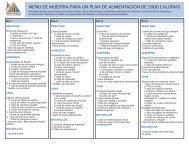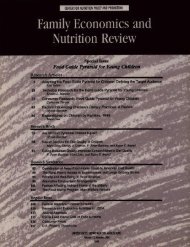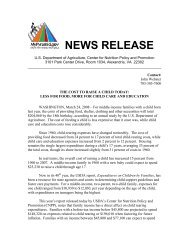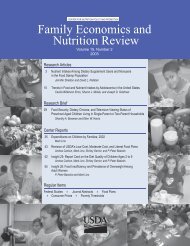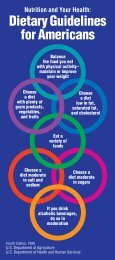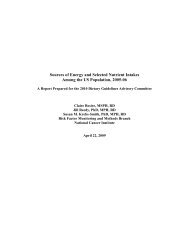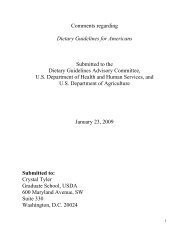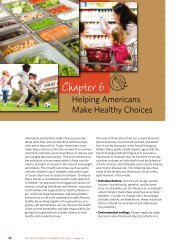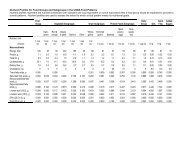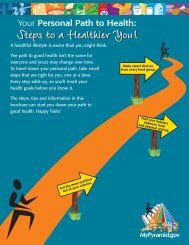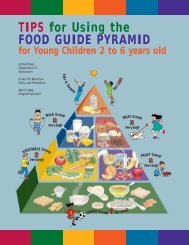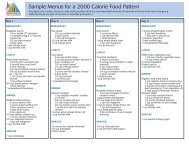Elderly Nutrition - Center for Nutrition Policy and Promotion - US ...
Elderly Nutrition - Center for Nutrition Policy and Promotion - US ...
Elderly Nutrition - Center for Nutrition Policy and Promotion - US ...
Create successful ePaper yourself
Turn your PDF publications into a flip-book with our unique Google optimized e-Paper software.
at greatest risk of developing nutrition<br />
problems. The Older Americans<br />
<strong>Nutrition</strong> Program also provides<br />
numerous services that emphasize<br />
preventive intervention programs<br />
through the use of nutrition screenings<br />
<strong>and</strong> education, as well as other healthrelated<br />
<strong>and</strong> social support services<br />
(Millen, Ohls, Ponza, & McCool,<br />
2002). It is also the largest U.S.<br />
community nutrition program <strong>for</strong> older<br />
adults, serving over 3 million meals<br />
daily across the Nation, including<br />
meals to almost 32,000 Georgians in<br />
2000 (Georgia Department of Human<br />
Resources, 2002).<br />
An Executive Summary of Title III<br />
programs reported significant health<br />
problems within the U.S. population<br />
of older adults (Millen et al., 2002,<br />
Ponza, Ohls, & Millen, 1996). Many<br />
of these health problems—such as<br />
cardiovascular disease, hypertension,<br />
diabetes mellitus, <strong>and</strong> obesity—are<br />
related to poor nutrition <strong>and</strong> physical<br />
activity <strong>and</strong> there<strong>for</strong>e could be lessened<br />
by interventions related to nutrition<br />
<strong>and</strong> physical activity. Data from other<br />
national sources (Millen et al., 2002;<br />
Ponza et al., 1996) <strong>and</strong> from within<br />
Georgia (Accettura, 2000; Aspinwall,<br />
2001; Brackett, 1999) indicate that<br />
participants in the Title III <strong>Nutrition</strong><br />
Program are at high nutritional risk <strong>and</strong><br />
have physical impairments included<br />
within the list of activities of daily<br />
living.<br />
Prior research by the University of<br />
Georgia’s Department of Foods <strong>and</strong><br />
<strong>Nutrition</strong> has exposed the high-risk<br />
status of many older adults in northeast<br />
Georgia who participate in the<br />
Older Americans <strong>Nutrition</strong> Program<br />
<strong>and</strong> has provided a snapshot of<br />
the probable characteristics of the<br />
program’s participants across the State.<br />
These studies found that more than<br />
50 percent of participants were at high<br />
nutritional risk <strong>and</strong> that more than 30<br />
percent were obese, had self-reported<br />
diabetes or poor glucose control, <strong>and</strong><br />
were hypertensive (Accettura, 2000;<br />
Brackett, 1999). These results indicate<br />
that this population is at increased<br />
nutritional risk, are at increased risk <strong>for</strong><br />
poor health overall, <strong>and</strong> could benefit<br />
greatly from nutrition intervention<br />
programs. Thus, a great need exists<br />
to develop, implement, <strong>and</strong> evaluate<br />
nutrition <strong>and</strong> health education programs<br />
to determine gains in knowledge<br />
<strong>and</strong> behavior changes. Hence, the<br />
goals of this study were to evaluate<br />
the effect of a nutrition education<br />
curriculum <strong>and</strong> an intervention<br />
program (leg exercises) designed to<br />
enhance older adults’ knowledge about<br />
nutrition <strong>and</strong> fitness <strong>and</strong> to improve<br />
their behaviors related to diet, physical<br />
activity, <strong>and</strong> overall health <strong>and</strong> wellbeing.<br />
National recommendations indicate<br />
that facilities with Older Americans<br />
<strong>Nutrition</strong> Programs are ideal settings<br />
<strong>for</strong> nutrition <strong>and</strong> health promotion<br />
programs in older adult populations<br />
(Millen et al., 2002). Most research<br />
with these program participants<br />
focused on documenting poor nutritional<br />
status <strong>and</strong> nutritional risk factors<br />
(Millen et al., 2002). The evaluation<br />
of combined nutrition <strong>and</strong> physical<br />
activity interventions targeted to older<br />
adults in this program in the Southeast<br />
is lacking. There<strong>for</strong>e, this evaluation is<br />
of great value <strong>for</strong> both the well-being<br />
of the older adults served <strong>and</strong> <strong>for</strong> the<br />
State in its quest to provide nutrition<br />
<strong>and</strong> health promotion activities <strong>and</strong><br />
services <strong>for</strong> this population.<br />
Methods<br />
The first phase of the study consisted<br />
of training the staff, followed by<br />
recruiting the participants, obtaining<br />
approvals from institutional review<br />
boards <strong>and</strong> in<strong>for</strong>med consent from<br />
participants, <strong>and</strong> administrating the<br />
pre-test, which consisted of a<br />
questionnaire <strong>and</strong> two fitness batteries.<br />
The second phase consisted of the<br />
intervention: nutrition education <strong>and</strong><br />
leg-exercise programs. The last phase<br />
was the post-test.<br />
Participant Recruitment<br />
<strong>and</strong> Criteria<br />
The directors of centers <strong>for</strong> senior<br />
citizens, county Extension agents,<br />
health educators, <strong>and</strong> staffs of Area<br />
Agencies on Aging helped to recruit<br />
participants, schedule interviews, <strong>and</strong><br />
remind participants when they were<br />
to take part in the study. Depending<br />
on the particular site, one or more of<br />
these individuals were responsible <strong>for</strong><br />
conducting the pre- <strong>and</strong> post-tests<br />
<strong>and</strong> <strong>for</strong> disseminating the nutrition<br />
education curriculum. Staff devoted<br />
to implementing the study received<br />
training from the University of<br />
Georgia’s Department of Foods <strong>and</strong><br />
<strong>Nutrition</strong> staff who were also available<br />
throughout the study to answer<br />
questions or address problems.<br />
Two criteria were used to determine<br />
whether individuals were eligible to<br />
participate in the study: (1) they had to<br />
be age 60 or older, <strong>and</strong> (2) they had to<br />
receive congregate meals provided by<br />
the Georgia Older Americans <strong>Nutrition</strong><br />
Program. Along with in<strong>for</strong>mation about<br />
in<strong>for</strong>med consent, an oral description<br />
of the study, including in<strong>for</strong>mation<br />
about the requirements, procedures,<br />
<strong>and</strong> benefits of participation, was given<br />
to all interested persons. We received<br />
written, in<strong>for</strong>med consent from 655<br />
men <strong>and</strong> women from 28 counties<br />
representing the 12 Planning Service<br />
Areas (geographic <strong>and</strong> programmatic<br />
regions) in Georgia that are served by<br />
the Area Agencies on Aging.<br />
Intervention Programs<br />
The nutrition education <strong>and</strong> physical<br />
activity intervention program was<br />
called “Take Charge of Your Health <strong>for</strong><br />
Older Adults.” These commercially<br />
available materials were developed by<br />
48 Family Economics <strong>and</strong> <strong>Nutrition</strong> Review



